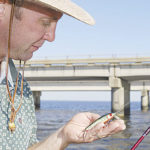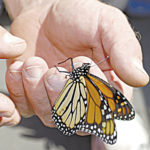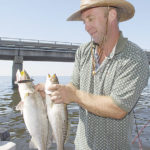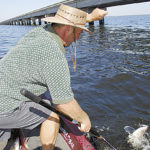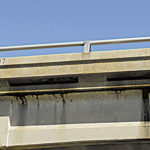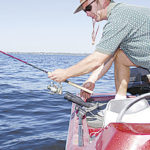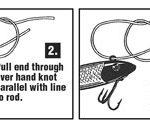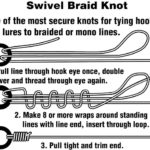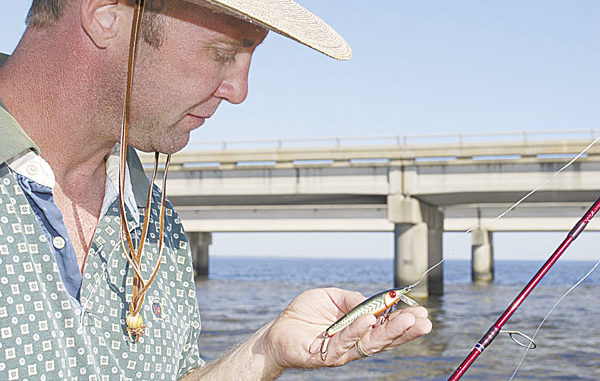
Most days this month, you’ll see this troll at Louisiana’s longest bridges. No need to pay him a toll, but you might want to after you try his tips.
Once upon a time, not long ago, a troll lived under a bridge. Well, actually there were two bridges — long ones, 24 miles each. And it wasn’t really a troll; it was a troller. And really, he didn’t live there; he just fished there — a lot.
It seems like fishing was a lot more diversified in the New Orleans area in the 1960s and early 1970s than it is now. A battalion of tight-lipped but legendary pompano-slayers prowled the waters of the area. For all practical purposes, they are gone.
At New Orleans’ doorstep, a strong tarpon fishery existed in Lake Pontchartrain. That’s pretty much gone too. Both the pompano and tarpon are still there, but the fishermen aren’t.
Then there were the legendary speckled trout trollers of Lake Pontchartrain. They doggedly pursued their yellow-mouthed prey, sometimes dragging their own hand-carved wooden plugs behind battered lake skiffs.
Modern bass boats hadn’t appeared yet, although a few fiberglass “banana boats” were around. Electric trolling motors had already been invented — in 1934, in fact. But the few to be seen were considered to be an affectation of freshwater fishermen.
The bridges across Lake Pontchartrain, the Trestle, the Highway 11 Bridge and the Causeway (it only had one span back in the day), once the haunts of the old trollers, are now cluttered with high-performance boats operated by electric trolling-motor jockeys. “Casters,” they are called by the few trollers left.
I thought that I had made my last ride with a speckled trout troller until I met Steve McCann at a Coastal Conservation Association fishing seminar in Madisonville in the fall of 2009. Young, at 40, for a troller, friendly and unsecretive, he asked me if I wanted to make a trip with him.
I jumped at the chance.
The weather was gorgeous. We had a balmy warm spell between cold fronts, and the wind was insignificant. When we set up the trip, McCann told me that the best times to troll the Causeway, his favorite bridge, were from September into April, with March being his favorite month.
This was prime time, and the movie-star handsome McCann was oozing self-confidence when I stepped in his boat at the Mandeville Boat Launch.
“We are going to catch fish,” he said. “I’m seeing butterflies all over.”
“Butterflies,” I thought to myself. “What do butterflies have to do with speckled trout?”
McCann idled his boat out of the harbor and jumped it up on step. Before I could settle in, he had made the less than two-mile run west to the long concrete bridges.
He didn’t waste much time rigging up after he stopped the boat. He snaked five rods of mixed ancestry out of the boat’s rod locker, and began tying MirrOlures from two modest-sized plastic boxes on their lines. Some of the MirrOlures looked new, but most were heavily battle-scarred from run-ins with the fangs of big speckled trout.
“I like to try different colors to find out what they want,” he explained as he rigged. “I usually start out early in the morning with darker colors, like black, purple and emerald green. Then I work my way up to brighter colors, like chartreuse, red/white, white/silver, especially on sunny days.”
While he rigged, I swatted flies. Some seemed like plain old houseflies, but others were stable flies, the kind that look like house flies but bite. They were everywhere. Looking up from rigging, McCann grinned and said that flies were a good sign too.
“I’ve noticed that when I’m in flies, I’m in fish,” he said. “Sometimes there are so many that that you want to leave, but you forget about them when the fish start biting.”
Then a butterfly lit on my hand. I looked up, and the air around the boat had butterflies dancing in all directions, orange ones, yellow ones, brown ones, solid-colored ones, spotted ones and speckled ones. The water’s surface beneath the bridge was dotted with butterflies too. Some were lying still; others were feebly and futilely flapping their wings.
“Butterflies are a good indicator that the fish will be at the bridges too,” explained McCann. “You see the most butterflies when conditions are stable before the next front. The crippled ones that you see on the water around you got hit by cars passing on the bridge.”
McCann dropped his trolling motor in the water and set it on low. As the boat chugged forward, he flipped five lines rigged with lures overboard one-by-one and planted them in rod holders. Two were mounted on each side of the boat, one near the bow and the other near the stern. The fifth rod was mounted vertically on the side of the steering console. The rear two rods, as well as the vertical one were set with the longest lines out, about the equivalent of four bridge spans.
Rods set, McCann took a seat in the bow of the boat next to the trolling motor. Part of his strategy is to stay near the trolling motor so that he can vary the speed of the boat.
“The whole secret in how I fish is that I vary my trolling speeds so that the lures rise and fall,” he explained. “I get lots of hits when I slow down or speed up.”
The weather was beautiful, with the temperature in the 70s and cerulean skies. I stretched out in the winter sun, like a coon sunning itself on a log.
“Now this is real nice fishing,” I thought to myself.
I am more used to constantly flailing the water when I fish for specks with artificials.
McCann made it look easy, coasting quietly between the two bridge spans. With the rhythmic thump-thump of cars passing overhead punctuating his remarks, he explained his strategy for fishing the long bridges.
First, he confided that he confines all his fishing to the area between the north shore of the big lake and the first elevated hump on the bridge.
During the Labor Day through April period, he fishes the bridge intensively, sometimes several times a week. Much of the time he fishes alone, although he loves to take kids.
“I fish so much on the spur of the moment when conditions are right,” he explained.
During the coldest period of the winter, Late December and January, he admits that fishing for speckled trout gets a little slower, but cautions that people who say that trout don’t bite during this time are just not fishing slow enough.
“During the coldest period, you have to troll so slow that you are constantly removing the mussels that grow on the bottom of the lake from your lure’s hooks,” he said.
March, he says with conviction, is the best month of the year to troll the Causeway.
“I don’t fish too much in the summer,” he admitted, “partly because of the heat and partly because my lawn-care business keeps me so busy then. When I do fish in the summer, it’s usually at night.”
Trolling at night is how he produced his biggest speckled trout to date, a 9.6-pound sow that ate a lipped sinking chartreuse MirrOlure.
As McCann talked, he kept his eyes moving from rod to rod, although he allowed that “when you get a hit trolling here, they usually really pound the bait. That’s why I use monofilament lines. They have more stretch and that helps keep the weight of the moving boat from tearing the bait out of their mouth.”
What he was watching for was the steady tick-tick-tick motion of the rod tip that indicated that the lure was fishing near enough to the bottom to effectively catch fish.
McCann said that he most often uses original Stren line and that he uses 10-, 12-, 17- and 20-pound-tests.
“Big trout have sharp teeth and will fray lines,” he said, “and with bigger test lines, I don’t have to retie as often. But on the other hand, smaller test lines allow lures to have better action and run deeper.”
McCann was following the advice that he usually gives beginning trollers, which is to start by trolling in the same direction as the wind and waves are moving. His rationale is that not only does it seem that he catches more fish this way, it is also less draining on his trolling motor battery. If the fish don’t bite trolling one way, he will often reverse course, because sometimes, he said, speckled trout will bite if the lures are trolled in one direction but not the other.
He notes that he likes best to fish on a falling tide, but cautions to be careful when using tide charts for predictions because so much of the tides in Lake Pontchartrain are wind-driven.
McCann is a firm believer in the effects of moon phase on fish feeding activity. His favorite times to fish are on new moons. He avoids fishing during periods when the moon is ¾-full or more.
An hour passed without a tap on the lures, but McCann seemed utterly unconcerned. He had been trolling slowly but steadily southward between the two bridge spans.
Then it happened. There was nothing subtle about it, and no mistaking the bite for anything else. About a quarter mile before the first hump in the bridge, a rod bowed deeply, then bucked violently.
The bronzed man sprang from his low position near the trolling motor like an uncoiled spring.
“Whoa, we got a nice one on,” he shouted as he slowed the trolling motor down and began the retrieve.
Before he got the 3-pound fish to the boat, another rod sprang to life and then another one. Three fish on at once.
Near the end of the retrieve, the speck on the first rod swam into the line on the second rod and hopelessly snarled it. McCann, a veteran of the fish wars, played in the second fish by retrieving the line hand-over-hand.
Then he grabbed the third rod. The fish was obviously bigger than the other two, and it threw its weight into the rod. In a few seconds, the line parted and the fish made off with McCann’s MirrOlure.
He quickly retrieved the last two lures, stopped the trolling motor and unflappably set about unhooking the two fish lying on the deck, then untangling what looked to be a hopeless mess of lines and treble hooks. In his experienced hands, it took only a few short minutes.
After tying a MirrOlure on the empty line, he cranked up the boat’s big motor and swung the boat out under the southbound span of the bridge and back northward. He returned to a point just before the spot where the bites occurred.
The southbound span of the bridge has numbers stenciled on a span every few spans. McCann had been watching the numbers, and knew exactly where the bites took place.
He quickly had the five rods in fishing position and the boat passing through the hotspot. Sure enough, the second pass yielded three more strikes in almost the same spot.
Without the snarls, McCann had the luxury of handing a rod off to Grant Gros, his 8-year-old fishing companion of the day. With every hit, McCann’s 5-foot, 11-inch body lept to action with unbelievable speed.
The next pass again produced strikes, but a boatful of eyes had been watching McCann’s success. Immediately after he trolled through the spot and retrieved his fish, an oversized fiberglass monster of a boat jumped into the spot with its two huge engines snarling. The boat churned in circles between the spans, while an oversized angler sat buddha-like on its bow and cast fruitlessly in the froth left by his boat’s engines.
McCann stood facing the boat from a distance.
“That’s what gets me out here,” he said, “people doing things like that.”
Still, he attempted another pass, but this one yielded only a single 12-inch trout. Even though the fish was tiny by Causeway standards, the sight of McCann catching the fish seemed to drive the frustrated anglers in the other boat to a frenzy. They hurled a huge anchor overboard and cast even more frenetically.
“Why do you think that we only had one bite on that pass and it was a little one?” he asked, obviously not expecting an answer. “That boat ran them all out. That happens a pretty good bit out here — a caster will anchor right where we catch a fish, and then we can’t pass the spot again.”
Still, McCann maintained that casters and trollers can get along well-enough on the long bridge, but admitted that things can get frustrating.
“It works best if everyone finds their own fish,” he said.
He admitted to sometimes reeling in fish with his rod tip pointed straight down and underwater and then quickly flipping his catch into the boat to avoid attracting attention.
“Some days, if you don’t do that,” he explained, “you will instantly have 10 boats move in on you.”
He summed up his views by noting trolling for speckled trout on the great bridge is slowly but surely giving way to casting. He also admitted, without animosity, that skillful casters can catch more fish than most trollers.
But he doesn’t plan to give up trolling.
“It’s fun; it’s relaxing. It reminds me of fishing shiners off the bank,” he said.
He also trolls along the Causeway because it is productive.
“I absolutely love to catch big fish, and from what I see, I tend to catch more here than anywhere, including the Trestles,” he said. “These fish just have so much more shoulders on
them.”
